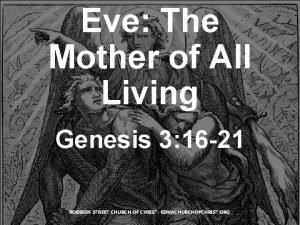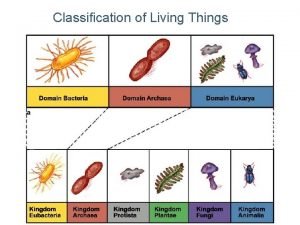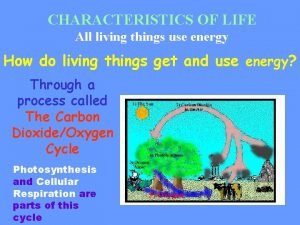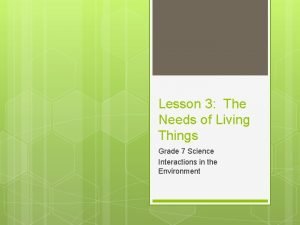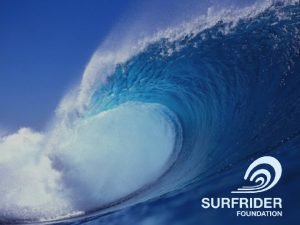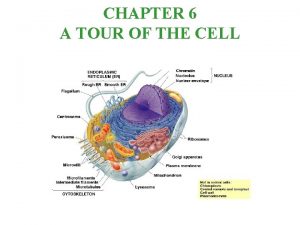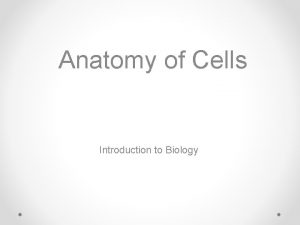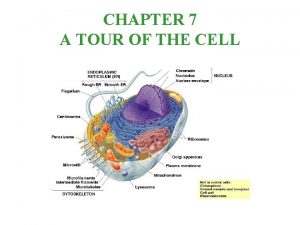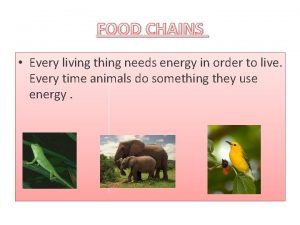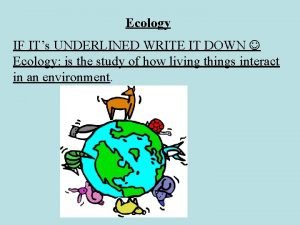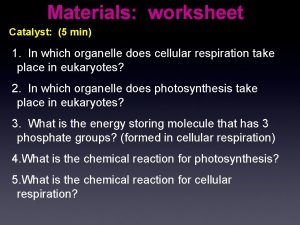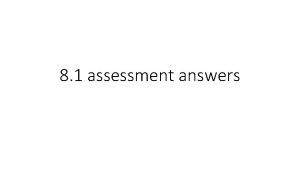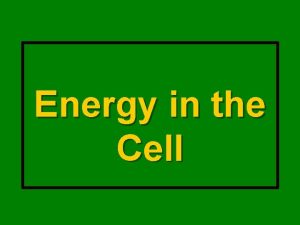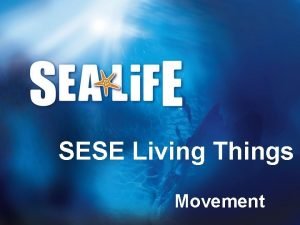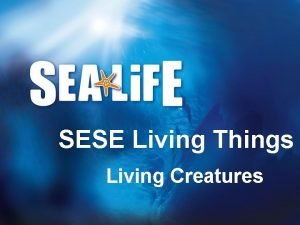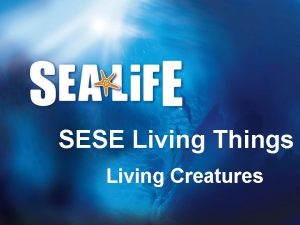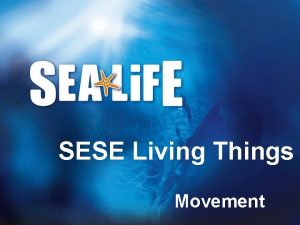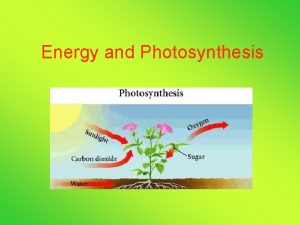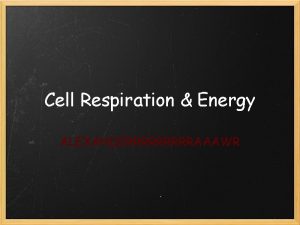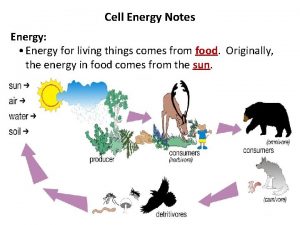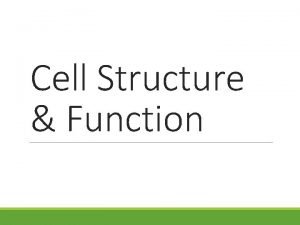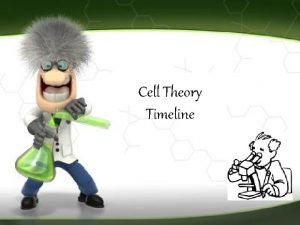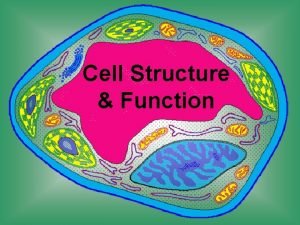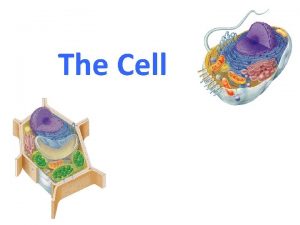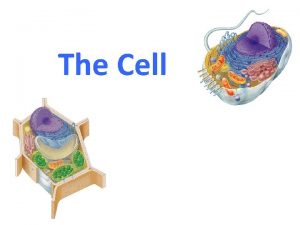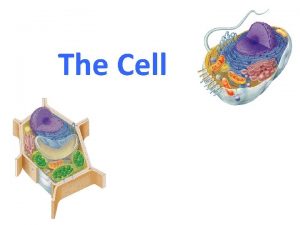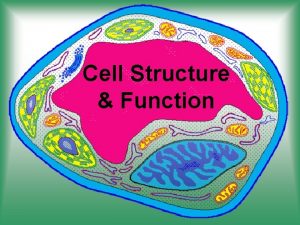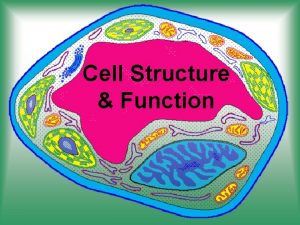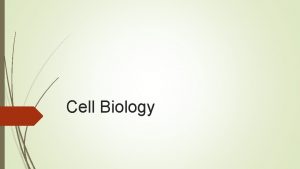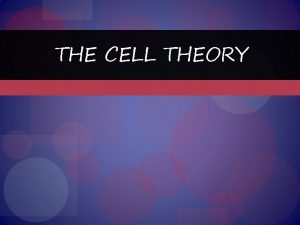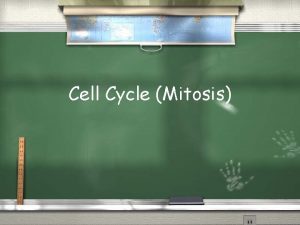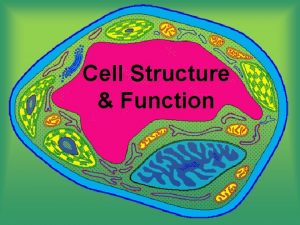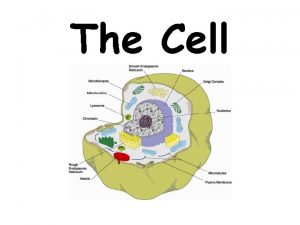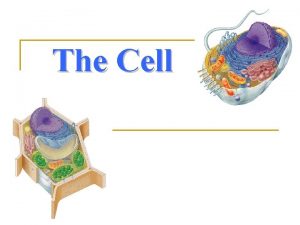Energy in the Cell Cell Energy All living





































































- Slides: 69

Energy in the Cell

• • • Cell Energy All living organisms must be able to obtain energy from the environment in which they live. The sun is the ultimate source of energy. Plants & other green organisms (Autotrophs) are able to trap the light energy in sunlight and store it in chemical energy for later use. Other organisms (heterotrophs) cannot use sunlight directly. They eat green plants. In that way, they obtain the energy stored in plants.

Work and the need for energy • Some process require cells to use energy. Examples: cell division, movement of flagella or cilia, and the production, transport, and storage of proteins. • There is a molecule in your cells that is a quick source of energy for any organelle in the cell that needs it. • The name of this energy molecule is adenosine triphosphate or ATP for short. • ATP is composed of an adenosine molecule with three phosphate groups attached.

• • Forming and Breaking Down ATP The charged phosphate groups act like the positive poles of two magnets. Bonding three phosphate groups to form ATP requires considerable energy. When only one phosphate group bonds, a small amount of energy is required and the chemical bond does not store much energy. This molecule is called adenosine monophosphate (AMP). When a second phosphate group is added, more energy is required to force the two groups together. This molecule is called adenosine diphosphate, or ADP.

Forming and Breaking Down ATP • An even greater amount of energy is required to force a third charged phosphate group close enough to the other two to form a bond. When this bond is broken, energy is released. • The energy of ATP becomes available to a cell when the molecule is broken down. Adenosine P P P Adenosine triphosphate (ATP) P Adenosine diphosphate (ADP) Adenosine P P P

How cells tap into the energy stored in ATP • When ATP is broken down and the energy is released, the energy must be captured and used efficiently by cells. • Many proteins have a specific site where ATP can bind.

How cells tap into the energy stored in ATP • Then, when the phosphate bond is broken and the energy released, the cell can use the energy for activities such as making a protein or transporting molecules through the plasma membrane. ATP Protein P ADP Energy

How cells tap into the energy stored in ATP • When ATP has been broken down to ADP, the ADP is released from the binding site in the protein and the binding site may then be filled by another ATP molecule.

Question A molecule of adenosine that has one phosphate group bonded to it is _____. A. AMP B. ADP C. ATP D. ACP

The answer is A. AMP is adenosine monophosphate. Adenosine P P P Adenosine triphosphate (ATP) P P Adenosine diphosphate (ADP) Adenosine P P The addition and release of a phosphate group on adenosine diphosphate creates a cycle of ATP formation and breakdown.

Question What is the function of the protein molecule shown in this diagram? ATP Protein P ADP Energy

This protein molecule has a specific binding site for ATP. In order to access the energy stored ATP, the protein molecule binds the ATP and uncouples one phosphate group. This action releases energy that is then available to the cell. ATP Protein P ADP Energy

Trapping Energy from Sunlight • • The process that uses the sun’s energy to make simple organic sugars is called photosynthesis. These simple sugars are converted into carbohydrates like starch or cellulose.

Trapping Energy from Sunlight • Photosynthesis happens in two phases. 1. The light-dependent reactions (Light Reactions) convert light energy into chemical energy. 2. The molecules of ATP produced in the lightdependent reactions are then used to fuel the lightindependent reactions (Dark Reactions) that produce simple sugars. • The general equation for photosynthesis is written as 6 CO 2 + 6 H 2 O→C 6 H 12 O 6 + 6 O 2

Light and Chlorophyll • Light travels in waves. The visible spectrum are the colors we can see. • ROY G BIV – red, orange, yellow, green, blue, indigo, violet are the colors of the visible spectrum. • Various colors of the spectrum are either absorbed or reflected by pigments. • A pigment is a compound that absorbs light. • The only reason we see color is due to light that reflects off the pigment in the object.

• • The chloroplast and pigments The pigment chlorophyll is found in the chloroplasts of the cells. The chloroplast contain stacks of membranes called thylakoid membranes used to trap the energy in the sun’s light. Clusters of these membranes are called photosystems. Although a photosystem contains several kinds of pigments, the most common is chlorophyll. Chlorophyll absorbs most wavelengths of light except green.

Light Reaction • Must occur in the light • Begins with the absorption of light in the chloroplast by the chlorophyll (a & b) • Mainly absorbs red and blue light from the spectrum. • Other pigments are known as carotenoids. These are accessory pigments like red, yellow, orange, and purple that you mainly see in the fall.

Light-Dependent Reactions • • As sunlight strikes the chlorophyll molecules in a photosystem of the thylakoid membrane, the energy in the light is transferred to electrons. These highly energized, or excited, electrons are passed from chlorophyll to an electron transport chain, a series of proteins embedded in the thylakoid membrane.

Light-Dependent Reactions • • At each step along the transport chain, the electrons lose energy. This “lost” energy can be used to form ATP from ADP, or to pump hydrogen ions into the center of the thylakoid disc. Sun Light energy transfers to chlorophyll. Chlorophyll passes energy down through the electron transport chain. Energized electrons provide energy that splits H 2 O H+ NADP+ bonds P to ADP forming oxygen ATP released NADPH for the use in light-independent reactions

Restoring electrons • To replace the lost electrons, molecules of water are split in the first photosystem. This reaction is called photolysis. Sun Chlorophyll H 2 O → 2Η+ + _1 O + 2 e 2 2 2 e- _1 O + 2 H+ 2 2 H 2 O

Restoring electrons • The oxygen produced by photolysis is released into the air and supplies the oxygen we breathe. • The electrons are returned to chlorophyll. • The hydrogen ions are pumped into the thylakoid, where they accumulate in high concentration.

Light-Dependent Reactions • Electrons are re-energized in a second photosystem and passed down a second electron transport chain. • The electrons are transferred to the stroma of the chloroplast. To do this, an electron carrier molecule called NADP is used. • NADP can combine with two excited electrons and a hydrogen ion (H+) to become NADPH. • NADPH will play an important role in the lightindependent reactions.

The Calvin Cycle (CO 2) (Unstable intermediate) (Ru. PB) ADP + ATP ADP + NADPH NADP+ (PGAL) (Sugars and other carbohydrates) Pg. 229 in textbook

The Calvin Cycle • • • AKA - Dark reactions Named after Melvin Calvin. Provides raw materials to produce almost everything for the cell. • Most common pathway for carbon fixation-the incorporation of Carbon dioxide into an organic compound. • Can occur in the dark or in the light.

The Calvin Cycle • Carbon fixation The carbon atom from CO 2 bonds with a five-carbon sugar called ribulose diphosphate (RDP or Ru. BP) to form an unstable six-carbon sugar. (CO 2) • The stroma in chloroplasts hosts the Calvin cycle. (Ru. BP)

The Calvin Cycle Formation of 3 -carbon molecules: The six-carbon sugar formed in Step A immediately splits to form two threecarbon molecules. (Unstable intermediate)

The Calvin Cycle Use of ATP and NADPH: A series of reactions involving ATP and NADPH from the light-dependent reactions converts the three-carbon molecules into phosphoglyceraldehyde (PGAL), three-carbon sugars with higher energy bonds. ATP ADP + NADPH NADP+ (PGAL)

The Calvin Cycle Sugar production: One out of every six molecules of PGAL is transferred to the cytoplasm and used in the synthesis of sugars and other carbohydrates. After three rounds of the cycle, six molecules of PGAL are produced. (PGAL) (Sugars and other carbohydrates)

The Calvin Cycle Ru. BP is replenished: Five molecules of PGAL, each with three carbon atoms, produce three molecules of the fivecarbon Ru. BP. This replenishes the Ru. BP that was used up, and the cycle can continue. ADP+ P ATP (PGAL)

Question 1 The process that uses the sun’s energy to make simple sugars is ____. A. cellular respiration B. glycolysis C. photosynthesis D. photolysis

The answer is C. Photosynthesis happens in two phases to make simple sugars and convert the sugars into complex carbohydrates for energy storage.

Question 2 The function accomplished by the lightdependent reactions is ____. A. energy storage B. sugar production C. carbon fixation D. conversion of sugar to PGAL

The answer is A. The light-dependent reactions transfer energy from the sun to chlorophyll, and pass energized electrons to proteins embedded in the thylakoid membrane for storage in ATP and NADPH molecules. Sun Light energy transfers to chlorophyll. Chlorophyll passes energy down through the electron transport chain. Energized electrons provide energy that splits H 2 O H+ NADP+ bonds P to ADP forming oxygen ATP released NADPH for the use in light-independent reactions

Question 3 The first step in the Calvin cycle is the ____. A. replenishing of ribulose biphosphate B. production of phosphoglyceraldehyde C. Splitting of six-carbon sugar into two threecarbon molecules D. Bonding of carbon to ribulose biphosphate

The answer is D. The carbon atom from CO 2 bonds with a five-carbon sugar to form an unstable six-carbon sugar. This molecule then splits to form two three-carbon molecules.

Question 4 How many rounds of the Calvin cycle must occur in order for one molecule of PGAL to be transferred to the cell’s cytoplasm? A. 1 B. 2 C. 3 D. 4

The answer is C. Each round of the Calvin cycle produces two molecules of PGAL.

Cellular Respiration • • • The process by which mitochondria break down food molecules to produce ATP is called cellular respiration. There are two phases of cellular respiration: Anaerobic and aerobic. The first phase, anaerobic—no oxygen is required, has two parts Glycolysis and Fermentation • The last phase is aerobic and requires oxygen to be completed.

Cellular Respiration • The complex process in which cells make ATP by breaking down organic compounds • The reverse of photosynthesis. C 6 H 12 O 6 + 6 O 2 → 6 CO 2 + 6 H 2 O • Both photosynthesis and cellular respiration are used by autotrophs and heterotrophs just use cellular respiration.

Glycolysis • Glycolysis is a series of chemical reactions in the cytoplasm of a cell that break down glucose, a six-carbon compound, into two molecules of pyruvic acid, a three-carbon compound. 4 ATP 2 ATP Glucose 2 ADP 4 ADP + 4 P 2 PGAL 2 Pyruvic acid 2 NAD+ 2 NADH + 2 H+

Glycolysis • • Glycolysis is not very effective, producing only two ATP molecules for each glucose molecule broken down. The efficiency of Glycolysis is only 3. 5% 4 ATP 2 ATP Glucose 2 ADP 4 ADP + 4 P 2 PGAL 2 Pyruvic acid 2 NAD+ 2 NADH + 2 H+

• • Fermentation The process used when no oxygen is available for further respiration. This doesn’t produce any further energy but changes pyruvic acid into other substances. During heavy exercise, when your cells are without oxygen for a short period of time, an anaerobic process called fermentation follows Glycolysis and provides a means to continue producing ATP until oxygen is available again.

Lactic acid fermentation • Lactic acid fermentation is one of the processes that supplies energy when oxygen is scarce. • In this process, the reactions that produced pyruvic acid are reversed. • Two molecules of pyruvic acid use NADH to form two molecules of lactic acid. • This releases NAD+ to be used in Glycolysis, allowing two ATP molecules to be formed for each glucose molecule.

Lactic acid fermentation • The lactic acid is transferred from muscle cells, to the liver that converts it back to pyruvic acid. • Useful in manufacturing cheese & yogurt. • Occurs in muscle during rapid exercise causing extreme soreness.

Alcoholic fermentation • Another type of fermentation, alcoholic fermentation, is used by yeast cells and some bacteria to produce CO 2 and ethyl alcohol. • Occurs in plant cells and micro-organisms as waste products. • The CO 2 is what makes bread to rise and beer to bubble.

Aerobic Respiration • The second major phase of cellular respiration is Aerobic respiration which requires oxygen. • Aerobic respiration takes place in the mitochondria. This phase consist of two parts called the Citric Acid or Krebs Cycle and the Electron Transport Chain (ETC). During the Citric Acid cycle the pyruvic acid breaks down into citric acid and carbon dioxide. The energy released during the process forms 2 ATP not counting the 2 formed in Glycolysis.

• Glycolysis Before citric acid cycle and electron transport chain can begin, pyruvic acid undergoes a series of reactions in which it gives off a molecule of CO 2 and combines with a molecule called coenzyme A to form acetyl-Co. A. Mitochondrial membrane Outside the mitochondrion Pyruvic acid CO 2 Inside the mitochondrion Pyruvic acid Coenzyme A Intermediate byproduct NAD+ - Co. A Acetyl-Co. A NADH + H+

• • The citric acid cycle IF there is oxygen available the following steps will take place. The citric acid cycle, also called the Krebs cycle, is a series of chemical reactions similar to the Calvin cycle in that the molecule used in the first reaction is also one of the end products For every turn of the cycle, one molecule of ATP and two molecules of carbon dioxide are produced. The mitochondria host the citric acid cycle.

The Citric Acid Cycle (Acetyl-Co. A) NADH + H+ NAD+ Oxaloacetic acid Citric acid NAD+ O= =O (CO 2) Citric Acid Cycle NAD+ NADH + H+ O= =O ADP + ATP FADH 2 FAD NADH + H+ (CO 2)

• Citric acid: The two-carbon compound acetyl-Co. A reacts with a fourcarbon compound called oxaloacetic acid to form citric acid, a six-carbon molecule. The citric acid cycle Acetyl-Co. A Oxaloacetic acid Citric acid

• The citric acid cycle Formation of CO 2: A molecule of CO 2 is formed, reducing the eventual product to a five-carbon compound. In the process, a molecule of NADH and H+ is produced. NAD+ NADH + H+ O= =O (CO 2)

• The citric acid cycle Formation of the second CO 2: Another molecule of NAD CO 2 is released, NADH + H forming a four-carbon O= =O ADP + (CO ) compound. One ATP molecule of ATP and a molecule of NADH are also produced. + 2 +

• Recycling of oxaloacetic acid: The citric acid cycle The four-carbon molecule goes through a series of reactions in which FADH 2, NADH, and H+ are formed. NADH + H The carbon chain is NAD rearranged, and oxaloacetic acid is again FADH FAD made available for the cycle. + + 2

The electron transport chain • In the electron transport chain, the carrier molecules NADH and FADH 2 gives up electrons that pass through a series of reactions. Oxygen is the final electron acceptor. Electron carrier proteins Enzyme Space between inner and outer membranes Inner membrane e- Electron pathway NADH NAD+ FADH 2 FAD 4 H+ + O 2 + 4 electrons H 2 O ADP + H 2 O ATP Center of mitochondrion

Overall, the electron transport chain adds 32 ATP molecules to the four already produced. Glucose Glycolysis Pyruvic Acid 2 ATP 2 NADH 6 ATP ETC Acetyl Co. A Krebs Cycle 2 ATP directly 6 NADH 18 ATP ETC 2 FADH 2 4 ATP ETC 38 Total ATP molecules made.

Aerobic Respiration • The efficiency of Aerobic Respiration is 66%. • Aerobic respiration is about 20 times more efficient than Glycolysis alone.

Comparing Photosynthesis and Cellular Respiration Table 9. 1 Comparison of Photosynthesis and Cellular Respiration Photosynthesis Cellular Respiration Food synthesized Food broken down Energy of glucose released Energy from sun stored in glucose Carbon dioxide taken in Oxygen given off Carbon dioxide given off Oxygen taken in Produces sugars from PGAL Produces CO 2 and H 2 O Requires light Does not require light Occurs only in presence of chlorophyll Occurs in all living cells

Question 1 What do the Calvin cycle and the Citric acid cycle have in common? A. The molecule used in the first reaction is also one of the end products. B. Both require input of ATP molecules. C. Both generate ADP. D. From every turn of the cycle, two molecules of carbon dioxide are produced.

The answer is A. In the Calvin cycle, Ru. BP bonds to carbon in the first step and is produced in the last step. In the citric acid cycle, oxaloacetic acid reacts in the first step and is recycled in the last step.

Question 2 The process by which mitochondria break down food molecules to produce ATP is called ____. A. photosynthesis B. cellular respiration C. the light-independent reaction D. the Calvin cycle

The answer is B. Photosynthesis, light-independent reactions, and the Calvin cycle all occur in plants.

Question 3 The three stages of cellular respiration are _____. A. Glycolysis, the Calvin cycle, and the electron transport chain B. carbon fixation, the citric acid cycle, and the electron transport chain C. Glycolysis, the citric acid cycle, and the electron transport chain D. the light-dependent reactions, the citric acid cycle and the electron transport chain

The answer is C. The first stage is anaerobic, but the last two stages require oxygen to be completed.

Question 4 Which of the following yields the greatest net ATP? A. Lactic acid fermentation B. Alcoholic fermentation C. Calvin cycle D. Cellular respiration

The answer is D. Cellular respiration is far more efficient in ATP production than the fermentation reactions. Comparison of Fermentation to Cellular Respiration Lactic Acid glucose glycolysis (pyruvic acid) Alcoholic Cellular respiration glucose glycolysis (pyruvic acid) carbon dioxide lactic acid alcohol water 2 ATP 38 ATP

Question 4 In which of the following structures do the light-dependent reactions of photosynthesis take place? A. C. B. D.

The answer is D. The light-dependent reactions of photosynthesis take place in the thylakoid membranes of chloroplasts.

Question 6 What component of thylakoid membranes absorbs specific wavelengths of sunlight? A. electrons B. pigments C. chloroplasts D. mitochondria

Question 7 Which of the following is a product of cellular respiration? A. lactic acid B. alcohol C. glucose D. carbon dioxide
 What is the smallest living unit of life
What is the smallest living unit of life Name all the lines name all the segments name all the rays
Name all the lines name all the segments name all the rays Living and nonliving things venn diagram
Living and nonliving things venn diagram Is a seed living or nonliving
Is a seed living or nonliving Living non living dead
Living non living dead 7 life processes of living things
7 life processes of living things Mother of all living
Mother of all living 8 levels of classification
8 levels of classification Cells are the building blocks of all living things
Cells are the building blocks of all living things Life cycle of all living things
Life cycle of all living things What are the 5 basic needs of all living things
What are the 5 basic needs of all living things Are all living things based on the metric system
Are all living things based on the metric system Throwaway living
Throwaway living A cell is a living unit greater than the sum of its parts
A cell is a living unit greater than the sum of its parts A cell is a living unit greater than the sum of its parts
A cell is a living unit greater than the sum of its parts Microfilament function
Microfilament function Chapter 20 viruses and prokaryotes
Chapter 20 viruses and prokaryotes Hát kết hợp bộ gõ cơ thể
Hát kết hợp bộ gõ cơ thể Frameset trong html5
Frameset trong html5 Bổ thể
Bổ thể Tỉ lệ cơ thể trẻ em
Tỉ lệ cơ thể trẻ em Gấu đi như thế nào
Gấu đi như thế nào Glasgow thang điểm
Glasgow thang điểm Hát lên người ơi
Hát lên người ơi Các môn thể thao bắt đầu bằng tiếng chạy
Các môn thể thao bắt đầu bằng tiếng chạy Thế nào là hệ số cao nhất
Thế nào là hệ số cao nhất Các châu lục và đại dương trên thế giới
Các châu lục và đại dương trên thế giới Công thức tiính động năng
Công thức tiính động năng Trời xanh đây là của chúng ta thể thơ
Trời xanh đây là của chúng ta thể thơ Mật thư tọa độ 5x5
Mật thư tọa độ 5x5 Phép trừ bù
Phép trừ bù Phản ứng thế ankan
Phản ứng thế ankan Các châu lục và đại dương trên thế giới
Các châu lục và đại dương trên thế giới Thơ thất ngôn tứ tuyệt đường luật
Thơ thất ngôn tứ tuyệt đường luật Quá trình desamine hóa có thể tạo ra
Quá trình desamine hóa có thể tạo ra Một số thể thơ truyền thống
Một số thể thơ truyền thống Cái miệng nó xinh thế
Cái miệng nó xinh thế Vẽ hình chiếu vuông góc của vật thể sau
Vẽ hình chiếu vuông góc của vật thể sau Biện pháp chống mỏi cơ
Biện pháp chống mỏi cơ đặc điểm cơ thể của người tối cổ
đặc điểm cơ thể của người tối cổ Thế nào là giọng cùng tên
Thế nào là giọng cùng tên Vẽ hình chiếu đứng bằng cạnh của vật thể
Vẽ hình chiếu đứng bằng cạnh của vật thể Phối cảnh
Phối cảnh Thẻ vin
Thẻ vin đại từ thay thế
đại từ thay thế điện thế nghỉ
điện thế nghỉ Tư thế ngồi viết
Tư thế ngồi viết Diễn thế sinh thái là
Diễn thế sinh thái là Các loại đột biến cấu trúc nhiễm sắc thể
Các loại đột biến cấu trúc nhiễm sắc thể So nguyen to
So nguyen to Tư thế ngồi viết
Tư thế ngồi viết Lời thề hippocrates
Lời thề hippocrates Thiếu nhi thế giới liên hoan
Thiếu nhi thế giới liên hoan ưu thế lai là gì
ưu thế lai là gì Hổ sinh sản vào mùa nào
Hổ sinh sản vào mùa nào Khi nào hổ mẹ dạy hổ con săn mồi
Khi nào hổ mẹ dạy hổ con săn mồi Hệ hô hấp
Hệ hô hấp Từ ngữ thể hiện lòng nhân hậu
Từ ngữ thể hiện lòng nhân hậu Thế nào là mạng điện lắp đặt kiểu nổi
Thế nào là mạng điện lắp đặt kiểu nổi Everything that is alive needs energy
Everything that is alive needs energy Food chains producers
Food chains producers Gets its energy from eating living things
Gets its energy from eating living things How living things obtain energy worksheet answers
How living things obtain energy worksheet answers How do heterotrophs and autotrophs differ
How do heterotrophs and autotrophs differ Energy energy transfer and general energy analysis
Energy energy transfer and general energy analysis Energy energy transfer and general energy analysis
Energy energy transfer and general energy analysis Love ever hurt never
Love ever hurt never Interventi sociali rivolti all'infanzia e all'adolescenza
Interventi sociali rivolti all'infanzia e all'adolescenza Crucified laid behind a stone
Crucified laid behind a stone I work all night i work all day to pay the bills
I work all night i work all day to pay the bills






